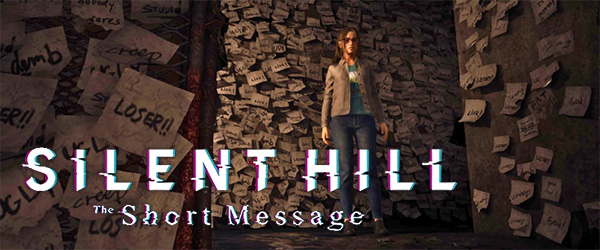
Silent Hill: The Short Message is a first-person horror game about wandering through looping, decrepit hallways in an abandoned apartment building, while confronting a secret, repressed guilt. And stop me if you've heard any of this before.
Silent Hill used to be a series that innovated, that pushed the envelope. The first game basically introduced the video-game-playing public to the concept of psychological horror. The second polished the formula to introspective perfection, while also providing a template for a plot twist that would be repeated in (what feels like) every horror game since -- at least the ones not named Resident Evil. Even action-oriented games like Dead Space ripped off Silent Hill 2.
Silent Hill 3 introduced gamers to a teenage girl protagonist who actually felt like a real person, instead of being a hyper-sexualized "boob ninja" in a bikini or skin-tight catsuit, while also providing jaw-dropping technical accomplishments. The moving, bleeding, living environmental textures of Silent Hill 3's Otherworld amazing and un-precedented at the time. And it's character models and lighting looked better than many games that would be released on the following generation of consoles.
Hideo Kojima's playable teaser P.T. spawned a cohort of horror games ripping off the formula of first-person looping hallway horrors, of which The Short Message is only the latest example. And heck, even P.T. was really only popularizing horror conventions that Silent Hill 4 had already started experimenting with a decade earlier.
This is a blunt and earnest depiction of teen depression, self-harm, and suicide.
The Short Message, on the other hand, is largely a retreading of horror gaming tropes that are quickly becoming tired and stale. The looping hallways were mind-blowing back when P.T. did it -- ten years ago. But I've seen it in seemingly every horror game since, from Layers of Fear to Visage to MadIson.
It isn't just general horror trends that The Short Message is retreading either. It's also invoking well-worn and frustrating habits that the Silent Hill series just refused to break in its never-ending quest to recreate the lightning-in-a-bottle that was Silent Hill 2. The character's repressed guilt being hidden from the player and revealed as a mid or late-game plot twist? Check. The person you're looking for being dead already? Check. Silent Hill acting as a purgatory that seems to be willfully trapping people until they confront and overcome aforementioned guilt? Check.
The heaviest, bluntest hammer Konami could find
One thing that The Short Message doesn't bother to copy from its ancestors is the subtlety and nuance that Silent Hill used to be famous for. The Short Message is unbelievably heavy-handed, blunt, and melo-dramatic. This is owing, in large part, to trepidation from Konami and/or developer HexaDrive about how to depict the game's subject matter: teen depression, self-harm, and suicide. It's a touchy subject, for sure. One has to give credit to Konami and HexaDrive for so directly addressing an issue that most game publishers and developers won't touch with a 20-foot pole.
HexaDrive's depiction of mental illness is not
as hopeless and fatalistic as Bloober's.
But this is also where The Short Message lands on one of its greatest strengths. It's blunt depiction of teen suicide is at least a hopeful and optimistic one -- one that is also grounded based on the very real social and technological issues that often motivate or catalyze real-life self-harm and suicide by actual teenagers. And this is not something that we should overlook in discussion of The Short Message. It's almost the polar opposite of how Team Bloober (the company that is developing the Silent Hill 2 remake) has historically treated the same topic. Bloober has always shown abuse victims as totally, fundamentally broken individuals for whom death or suicide is a welcome release that spares the world from their burden.
In contrast to Bloober, The Short Message wants depressed teens to know that they are not broken, that they can get help, and that there are people out there who care about them and would miss them and would be there for them in their times of need. The Short Message wants people to know that recognizing the red flags, and talking to the person can save their life, and that, for the depressed individual, things will get better.
If nothing else, The Short Message has its heart in the right place.
And let's face it, teenagers aren't exactly known for subtlety or nuance. Teenagers do tend to blow things out of proportion and be melo-dramatic. So it's hard for me to hold The Short Message's overly-blunt and melo-dramatic dialogue against it. Yeah it's cringe-worthy at times, but it's cringey in exactly the way that real-life teenagers are often cringey. There might also be more intentionality behind the blunt, cringey dialogue than is apparent at the surface level. Does the heavy-handed and cringey dialogue represent the literal events as they actually happened? Or are we seeing the world as the teenage character sees it?
[More]